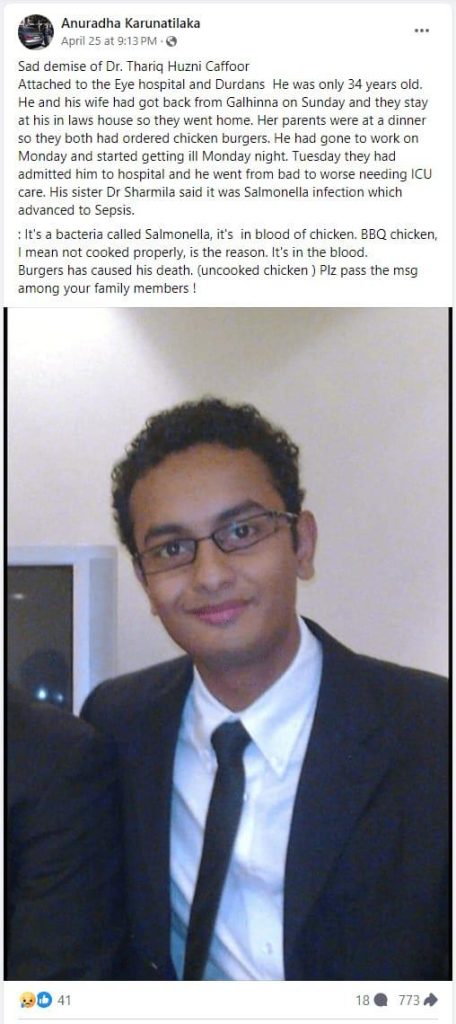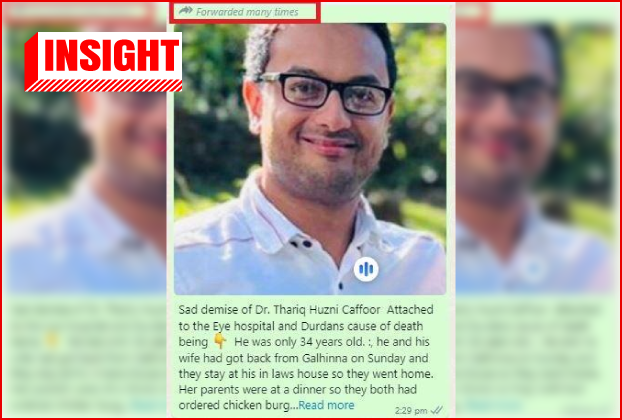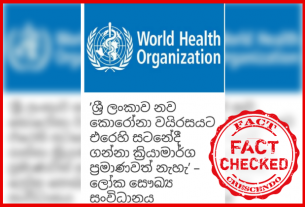Subscribe to our WhatsApp Channel
Social media posts claimed that a doctor had succumbed to a Salmonella infection, sparking widespread curiosity. In response, the FactCrescendo team conducted an investigation to uncover the veracity of these claims. Here are our findings.
Social Media Posts:
“Sad demise of Dr. Thariq Huzni Caffoor attached to the Eye hospital and Durdans. He was only 34 years old. He and his wife had returned from Galhinna on Sunday and stayed at his in-law’s house, so they went home. Her parents were at a dinner, so they both ordered chicken burgers. He had gone to work on Monday and started getting ill Monday night. Tuesday, they admitted him to the hospital, and he went from bad to worse, needing ICU care. His sister, Dr Sharmila, said it was a Salmonella infection which advanced to Sepsis.
: It’s a bacteria called Salmonella. It’s in the blood of chicken. BBQ chicken, I mean not cooked properly, is the reason.
Burgers has caused his death. (uncooked chicken) Please pass the msg among your family members!”
-Copied-
This was shared through the internet with the photo of the doctor mentioned above in both Sinhala and English languages.

This post was also shared on WhatsApp as well.

Many people were curious about this post and needed to confirm whether this news was accurate. Did Dr. Thariq Huzni Gaffoor die of a Salmonella infection? If yes, what was the source of the Salmonella bacteria? Was that really the chicken burger that he had eaten the day before? So, at the request of many followers, we decided to fact-check this.
Explainer:
We tried to find this news from the mainstream media but couldn’t find any related news.
So, we searched on social media, and posts were saying that a doctor named Dr Thariq Huzni Gafoor from Galhinna, Kandy, had died on the 22nd of April. Here, here and here for those posts. Archived Link | Archived Link
We called the people who were mentioned in the posts to know whether this was true or not. They confirmed that Dr. Thariq Huzni Gafoor had died due to a Salmonella infection, and the post-mortem results have confirmed this fact.
Also, we asked if it was confirmed that the source of Salmonella was the chicken burger that he had eaten the day before. But they said that doctors said that there is no evidence to confirm that which was the source. Also, the doctors who treated Dr Thariq had said that Salmonella could be in the human body without activating for about two weeks. So, the Salmonella source can be anything Dr Thariq had eaten within two weeks.
MOH Office – Poojapitiya –
We inquired about this from the MOH office in Poojapitiya, where Galhinna, the doctor’s residential area, belongs. The officers there also confirmed that this was true and that Dr Thariq had died of Salmonella infection.
Deputy Director General of Food Advisory Committee, Ministry of Health –
Deputy Director General of the Food Advisory Committee of the Ministry of Health, Dr Thilak Siriwardana, also confirmed that Dr Thariq, as in the social media posts, had died of Salmonella infection.
However, Dr Thilak Siriwardana said that the source of the bacteria has yet to be confirmed. Dr. Thariq had dined at a few different places days before, and no other person who had eaten at the same restaurant as Dr. Thariq had been reported to have any symptoms or complications. The time period between having chicken burgers and death is not very long, and that time is mostly not enough to activate Salmonella and cause death. However, laboratory tests are still conducted, and the verifying data can be given after those results.
What is Salmonella?
Salmonella are bacteria that make people sick.
What illness do people get from Salmonella infection?
Most types of Salmonella cause salmonellosis, which is the focus of this web article. Among those species some types cause typhoid fever or paratyphoid fever.More details can be read here
What are the symptoms of infection?
Most people with Salmonella infection have diarrhoea, fever, and stomach cramps.
Symptoms usually begin six hours to six days after infection and last four to seven days. However, some people do not develop symptoms for several weeks after infection, and others experience symptoms for several weeks.
Salmonella strains sometimes cause infection in urine, blood, bones, joints, or the nervous system (spinal fluid and brain) and can cause severe disease.
How is Salmonella infection diagnosed?
Salmonella infection is diagnosed when a laboratory test detects Salmonella bacteria in a person’s stool (poop), body tissue, or fluids.
How is infection treated?
Most people recover from Salmonella infection within four to seven days without antibiotics. People sick with a Salmonella infection should drink extra fluids as long as the diarrhoea lasts.
Antibiotic treatment is recommended for:
- People with severe illness
- People with a weakened immune system, such as from HIV infection or chemotherapy treatment
- Adults older than 50 who have medical problems, such as heart disease
- Infants (children younger than 12 months).
- Adults age 65 or older
Can infection cause long-term health problems?
Most people with diarrhoea caused by Salmonella recover completely, although some people’s bowel habits (frequency and consistency of poop) may not return to normal for a few months.
Some people with Salmonella infection develop joint pain, called reactive arthritis after the infection has ended. Reactive arthritis can last months or years and can be challenging to treat. Some people with reactive arthritis develop irritation of the eyes and pain when urinating.
How do people get infected?
Salmonella live in the intestines of people and animals. People can get Salmonella infection from a variety of sources, including;
- Eating contaminated food or drinking contaminated water
- Touching infected animals, their faeces, or their environment
Who is more likely to get an infection and severe illness?
- Children under five are the most likely to get a Salmonella infection.
- Infants (children younger than 12 months) not breastfed are more likely to get a Salmonella infection.
- Infants, adults aged 65 and older, and people with a weakened immune system are the most likely to have severe infections.
- People taking certain medicines (for example, stomach acid reducers) are at increased risk of infection.
What should I know about antimicrobial resistance and Salmonella?
Antimicrobial resistance happens when germs like bacteria and fungi develop the ability to defeat the drugs designed to kill them. That means the germs are not killed and continue to grow. Salmonella resistance to essential antibiotics is increasing, which can limit treatment options for people with severe infections. One way to slow down the development of antimicrobial resistance is by appropriate use of antibiotics.
What can be done to prevent antimicrobial resistance and resistant bacteria?
Appropriate use of antibiotics in people and animals (use only when needed and exactly as prescribed) can help prevent antimicrobial resistance and the spread of resistant bacteria.
How common is Salmonella infection?
The Centers for Disease Control and Prevention estimates that Salmonella causes about 1.35 million illnesses, 26,500 hospitalisations, and 420 deaths annually.
Source: CDC
Medical Research Institute (MRI) –
We contacted Dr. Sujatha Pathirage, senior consultant on microbiology and assistant analyst of the medical research institute, by phone to learn more about this.
“There are two types of Salmonella: Salmonella that causes typhoid and not causing typhoid. Four species can cause typhoid, and about 3000 species do not.”
This bacterium can be transmitted from person to person through the stool of an infected person. It can also be transmitted by touching someone without washing hands well after using the toilet or contaminating water and food (especially food eaten without cooking).
The doctor mentioned in that post has been infected with this type of Salmonella. Here, Salmonella is contaminated with blood. Salmonella can be found everywhere, such as in chicken that hasn’t been prepared more than 60°C and can be contaminated with Salmonella without dying.
So, as mentioned in the posts related to the above incident, the chicken burger could be contaminated with Salmonella if it was not cooked under the recommended heat. Also, Dr Sujatha Pathirage said this could be contaminated with any food.
Dr Sujatha further explained that many cases of Salmonella infection are recorded in the country. Many of them can be cured from the treatments, but there are some cases which can be fatal. Such situations can occur when Salmonella is activated in collaboration with another pathogen.
Prevention Methods –
Dr Sujatha indicated that the general prevention concept of Salmonella is a common prevention practice for food-borne diseases.
The water sources used for drinking and cooking must be clear and non-polluted.
It is essential to be attentive while buying meat. Meat shops must follow guidelines during the process. Knives used to cut meat and pots used to store it should also be clean and non-polluted.
Public Health Inspector (PHI) – W.G.L. Sasanka
Here are the instructions for being more attentive while consuming chicken at home.
Salmonella is naturally present in chicken. Therefore, it is possible to contaminate ourselves with Salmonella through careless use of chicken in our daily lives. When this bacterium is contaminated, stomach cramps, diarrhoea, vomiting, and sometimes severe symptoms can occur. So, it is important to be aware of a few facts about chicken, from buying to cooking.
- When chicken is bought, keeping it away from other cooked, pre-cooked or half-cooked food is essential. This can help to avoid cross-contamination.
- The polythene wrapping of the chicken should be removed and discarded carefully, and it should not be used again for other purposes.
- If the skin is not removed, chicken skin should be removed before chopping it into pieces. All equipment used to handle chicken, including a sink, knife and hands, should be thoroughly washed with soap.
- It is essential to keep two cutting boards in the kitchen; one is used to cut meat, and the other is used to cut food items. They also should be cleaned well both before and after use.
- While cooking, you must be attentive to whether it is fully cooked. To destroy pathogens in meat, they should be cooked appropriately.
Senior Consultant on Microbiology and Assistant Analyst of the Medical Research Institute, Dr Sujatha Pathirage, indicated that following the above instructions may help control the contamination and distribution of many pathogens, including Salmonella.
Follow us and stay up to date with our latest fact checks.
Facebook | Twitter | Instagram | Google News | TikTok

Title:Are you aware of Salmonella bacteria? Did a doctor in Sri Lanka recently pass away from a Salmonella infection?
Fact Check By: Fact Crescendo TeamResult: Insight






